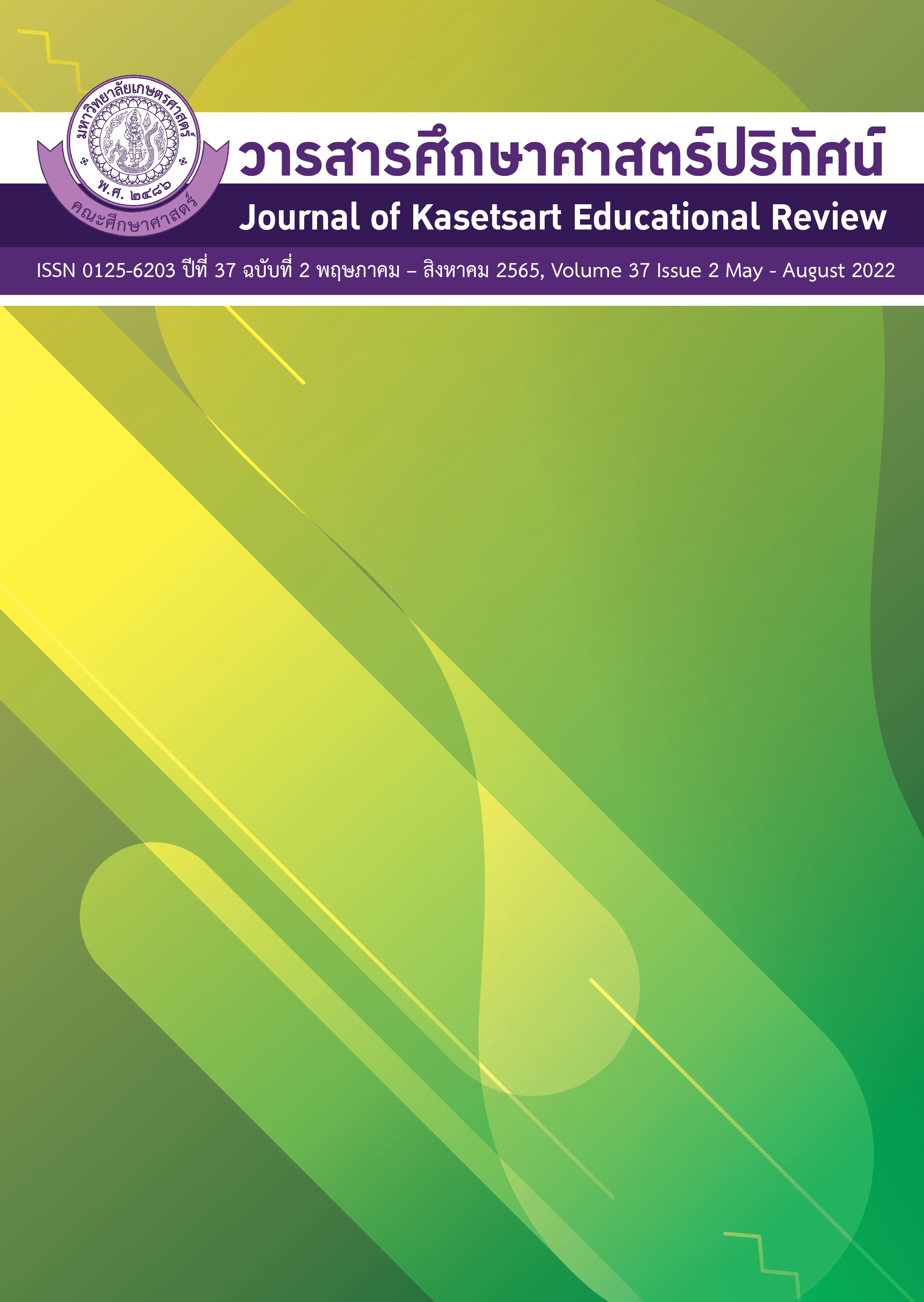ผลการใช้หน่วยการเรียนรู้วิทยาศาสตร์ตามแนวทางสะเต็มศึกษา เรื่อง ต้นอ่อนทานตะวัน เพื่อส่งเสริมความสามารถในการแก้ปัญหาของนักเรียนชั้นมัธยมศึกษาปีที่ 1
คำสำคัญ:
ความสามารถในการแก้ปัญหา, สะเต็มศึกษา, หน่วยการเรียนรู้วิทยาศาสตร์บทคัดย่อ
การวิจัยครั้งนี้มีวัตถุประสงค์เพื่อศึกษาผลการใช้หน่วยการเรียนรู้วิทยาศาสตร์ตามแนวทางสะเต็มศึกษา เรื่อง ต้นอ่อนทานตะวัน เพื่อส่งเสริมความสามารถในการแก้ปัญหาของนักเรียนชั้นมัธยมศึกษาปีที่ 1 โดยพิจารณาจาก 3 ประเด็น ดังนี้ 1) ความสามารถในการแก้ปัญหาของนักเรียน 2) ความเข้าใจเนื้อหาวิทยาศาสตร์ของนักเรียน และ3) ความพึงพอใจของนักเรียนที่มีต่อการจัดการเรียนรู้โดยใช้หน่วยการเรียนรู้ฯ งานวิจัยนี้เป็นการวิจัยเชิงทดลองขั้นต้น แบบกลุ่มเดียววัดก่อนและหลังการทดลอง กลุ่มที่ศึกษาเป็นนักเรียนชั้นมัธยมศึกษาปีที่ 1 โรงเรียนแห่งหนึ่ง สังกัดสำนักงานเขตพื้นที่การศึกษาประถมศึกษากรุงเทพมหานคร เขตห้วยขวาง จังหวัดกรุงเทพมหานคร ภาคเรียนที่ 2 ปีการศึกษา 2561 จำนวน 30 คน ได้มาจากการเลือกแบบเจาะจง เครื่องมือวิจัย ประกอบด้วย 1) แบบทดสอบความสามารถในการแก้ปัญหาของนักเรียนชั้นมัธยมศึกษาปีที่ 1 2) แบบวัดความเข้าใจเนื้อหาวิทยาศาสตร์ และ3) แบบสอบถามความพึงพอใจของนักเรียนที่มีต่อการจัดการเรียนรู้ สถิติที่ใช้ในการวิเคราะห์ข้อมูล ได้แก่ ร้อยละ ค่าเฉลี่ย ค่าส่วนเบี่ยงเบนมาตรฐาน การทดสอบค่าทีแบบกลุ่มเดียวและแบบกลุ่มตัวอย่างสัมพันธ์กัน ผลการวิจัย พบว่า
1. คะแนนเฉลี่ยความสามารถในการแก้ปัญหาโดยภาพรวมของนักเรียนหลังเรียนด้วยหน่วยการเรียนรู้ฯ สูงกว่าก่อนเรียน อย่างมีนัยสำคัญทางสถิติที่ระดับ .05
(t = 9.417, p = .000)
2. คะแนนเฉลี่ยความเข้าใจเนื้อหาวิทยาศาสตร์ของนักเรียนหลังเรียนด้วยหน่วยการเรียนรู้ฯ สูงกว่าก่อนเรียน (t = 18.508, p = .000) และสูงกว่าเกณฑ์ที่กำหนด ร้อยละ 65 อย่างมีนัยสำคัญทางสถิติที่ระดับ .05
(t = 9.967, p = .000)
3. คะแนนเฉลี่ยความพึงพอใจของนักเรียนที่มีต่อการจัดการเรียนรู้โดยภาพรวมและรายด้านหลังเรียนด้วยหน่วยการเรียนรู้ฯ อยู่ในระดับมาก
เอกสารอ้างอิง
Basic Education Commission. (2010). National Education Act B.E.2542 (1999) and Amendment (No.3) B.E.2553 (2010). Bangkok: Express Transportation Organization of Thailand.
Chaolumbua, S. (2015). Development of an additional STEM integrated science curriculum on “Sugar Cane” for the 9th grade students (Doctoral dissertation). Srinakharinwirot University, Faculty of Education, Science Education.
Chuaychoocherd, N. (2014). Study on learning achievement and solving-problem ability in science of Matthayom Suksa 2 students with the use of science activity packages. Journal of Humanities and Social Sciences, Srinakharinwirot Research and Development 6(12): 87-94.
Dejarnette. (2012). America’s children: providing early exposure to STEM (science, technology, engineering and math) initiatives. Education. 133(1): 77 – 84.
Department of Academic Affairs, Ministry of Education. (2001). Manual of Learning Management, Mathematics strand. Bangkok: Express Transportation Organization of Thailand.
Fitz - Gibbon & Carol, T. (1987). How to Design a Program Evaluation. Newbury Park: Sage.
Kaemanee, T. (2015). Models of teaching and learning: variety of alternatives. Bangkok: Chulalongkorn University.
Katetat, S. (1998). Conceptual framework of scientific and technological directions of Thailand. Academic Journal. 1(5):2-15.
Koehler, C.; Faraclas, E.; Giblin, D.; & Kazerounian, K. (2013). The Nexus between science literacy and technical literacy: a state by state analysis of engineering content in state science standards. Journal of STEM Education. 14(3): 5 - 12.
National Research Council of the National Academes. (2012). Successful K-12 STEM education: identifying effective approaches in science, technology, engineering, and mathematics. Washington D.C.: The National Academic Press.
Office of the Education Council. (2017). National Education Plan 2017-2036. Bangkok: Prik Wan Graphic Co.,Ltd.
Pilantaowad, O. (2006). Persuasive Communication. Bangkok: Chulalongkorn University Printing House.
Poonruang, A. (2015). A comparison of learning achievement and ability in problem solving in chemistry of life through STEM education approach of Grade -11 students. The 1st National Education Conference. Educational Management for Local Development towards ASEAN Community: New Direction in the 21st Century. Srinakharinwirot University.
Ramsri, S. (2015). Effects of learning management using STEM activity approach on learning achievement and problem-solving ability in science of Matthayom Suksa 2 students.
Taweerat, P. (1997). Research methods in behavioral sciences and social sciences. (the 7th edition). Bangkok: Educational and Psychological Test Bureau, Srinakharinwirot University.
The Institute for the Promotion of Teaching Science and Technology. (2014). Basic knowledge about STEM. (The 1st edition). Bangkok: The Institute for the Promotion of Teaching Science and Technology.
The Partnership for 21st Century Skills 2011. Framework for 21st Century Learning [Online] available from http://www. P.21.org. Access on March 5, 2017.
Wongyai, W. (2011). Curriculum development and instruction: a new dimension. Bangkok: Rungroeng.
ดาวน์โหลด
เผยแพร่แล้ว
ฉบับ
ประเภทบทความ
สัญญาอนุญาต
ลิขสิทธิ์ (c) 2022 วารสารศึกษาศาสตร์ปริทัศน์

อนุญาตภายใต้เงื่อนไข Creative Commons Attribution-NonCommercial-NoDerivatives 4.0 International License.
บทความทุกบทความเป็นลิขสิทธิ์ของวารสารคณะศึกษาศาสตร์ มหาวิทยาลัยเกษตรศาสตร์ วิทยาเขตบางเขน
วารสารศึกษาศาสตร์ปริทัศน์ (Kasetsart Educational Review)






